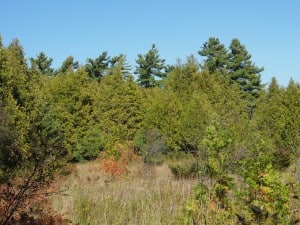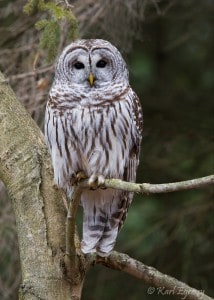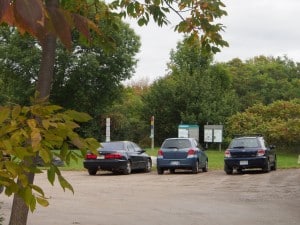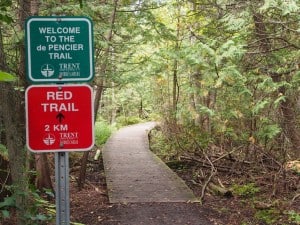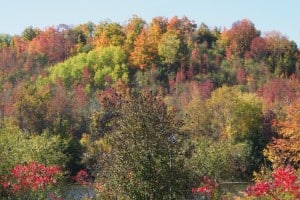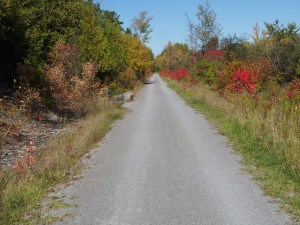TRENT NATURE AREAS – university campus offers easy access to local nature
With over 1,400 acres of land situated on the banks of Otonabee River and Trent Canal and over 30 kilometres of nature trails, Trent University offers some of the best nature-viewing opportunities in the Peterborough area. The combination of mature forest, drumlins, open fields, wetlands, streams and the Trent-Severn Waterway provides a rich offering of plant and animal life. As Trent University celebrates its 50th anniversary, I’d like to provide an overview of some of the most popular nature areas on the campus and what you can expect to see there. For more detailed information and to print off trail maps, go to http://trentu.ca/natureareas/overview.php
Wildlife Sanctuary Nature Area – Located east of University Road, the Wildlife Sanctuary is the largest and most extensively visited nature area on the Symons Campus. The entrance and parking lot are situated just south of Nassau Mills Road. The three trails – Blue, Yellow and Red – average about 2.5 km in length and are clearly shown on a large sign at the entrance. The Blue Trail takes you through the most diverse range of habitats, including lowland forest, wetlands and upland fields. At the north end, it passes behind the Camp Kawartha Environment Centre, where you can watch birds coming to a window feeder. The wetlands offer up a wonderful frog chorus in April, especially in the Silver Maple swamps. You will hear the clamorous voices of Wood Frogs, Chorus Frogs, Spring Peepers and, by month’s end, Northern Leopard Frogs. At the sound end of the trail – or by branching off onto the Yellow Trail – you’ll come across an area where dozens of Tree Swallow boxes have been erected. The Bergs, a Peterborough family that take their dogs on daily morning walks in the Trent Nature Areas, describes the swallow spectacle this way: “It is always wonderful when the Tree Swallows return in the spring, filling the air with their wonderful swooping, diving and lovely chattering. Then, one day in late summer, they depart en masse, leaving the field where their nest boxes remain, conspicuously quiet once again.” They also recommend the swallow field as a great place to observe the amazing flight displays of American Woodcocks in the spring.
In winter visits to the Wildlife Sanctuary and adjacent Canal Nature Area, the Bergs often encounter Barred Owls and sometimes even Northern Saw-whet Owls. As for reptiles and amphibians, they’ve seen Milk, Eastern Garter and Redbelly snakes as well as Blue-spotted Salamanders. Porcupines are a regular occurrence in winter and spring and sometimes even get a glimpse at a Coyote. These are two good reasons to keep your dog on a leash! White-tailed Deer, too, are frequently observed in this area. Deer tracks, scat, bedding sites and signs of where the animals have browsed are easy to find, especially in winter.
To enhance your chances of seeing wildlife, the Bergs advise you to go early in the day and to go often. “There are many ecotones – transition areas where two habitat types meet – which are particularly rich in wildlife diversity and also wonderful places to observe the myriad signs of seasonal change throughout the year,” the family told me.
Canal Nature Area – Located between the west side of University Road and the east bank of the Trent Severn Canal, the entrance to the Canal Nature Area is directly opposite the parking lot to the Wildlife Sanctuary. The John de Pencier Trail takes you through a diversity of habitats, starting with a boardwalk that crosses a damp, mixed forest with a wide variety of ferns. The trail then passes through stands of mature Sugar Maples, White Ash and Red Oaks, before winding down to the Canal. Here, you pass by several very impressive American Beech, Sugar Maple and Eastern Hemlock. The Canal bank provides viewing areas for waterfowl migration, and there are even comfortable benches to sit on. The de Pencier Trail is a great choice if you enjoy birding. So far this year, 92 species have been recorded, including 15 species of warblers. Many of these sightings are courtesy of 15- year- old Luke Berg, one of Peterborough’s best birders. The south branch of the Morton Family Trail along the canal can also be rich in birds. If you take this same trail to the top of the hill, you’ll find a lovely stand of Black Locust trees, where the remains of the old farmstead can still be seen. This is a good spot to see and hear Indigo Bunting in the spring and summer.
South Drumlin Nature Area – Adjacent to Nassau Mills Road and bordering the western edge of the Trent Canal, the South Drumlin is another great area to visit. You’ll find a number of informal trails leading up the drumlin. Much of this area is covered by beautiful deciduous forest dominated by Sugar Maple, White Ash, and even a few mature Black Cherry trees. The forest offers a particularly attractive display of both spring wildflowers and fall leaves. According to Dr. Erica Nol, a biology professor at Trent, this is a great area to see and hear breeding Ovenbirds, Red-eyed Vireos and sometimes even a Wood Thrush. In the fields on the west side of the drumlin, you can also find Field Sparrows and Brown Thrashers. I have also found that the trees along the edge of the Canal are a great spot to observe Baltimore Orioles.
Lady Eaton Drumlin Nature Area – The drumlin is situated between Water Street and West Bank Drive (the main campus road). The northern boundary is Woodland Drive. The main trail to the top of the drumlin can be accessed from the west side of West Bank Drive, about 100 metres north of the entrance to Blackburn Hall. You can also access the drumlin from the north parking lot near Woodland Dr. The drumlin is a distinctive landmark that provides magnificent panoramic views to the north and southeast. The eastern slope offers an attractive backdrop to Lady Eaton College, particularly in the fall. The northwestern portion of the drumlin near Woodland Drive supports a deciduous forest with a varied native flora that includes Blue Beech and Bitternut Hickory. The spring wildflower display here is wonderful.
Promise Rock Nature Area – Probably the best birding destination on Campus, Promise Rock borders the west, and to a lesser extent the east side of the Rotary Greenway Trail, starting about 500 metres north of where the Rotary Trail begins at East Bank Drive. You can also access the area from a gravel path located directly opposite the parking lot at the Lock 22 picnic area. Although White Cedar is the most abundant tree species here, White Pines give the impression of dominance because of their great height (over 30 m tall) and trunk size. Large Eastern Hemlock, White Spruce and Balsam Fir are also present.
Chris Risley, an MNR biologist and keen birder, has looked at local bird checklists submitted to eBird, on online checklist program, and concluded that Promise Rock has the second highest number of bird sightings for all of Peterborough County! So far this year, an amazing 134 species have been reported from this area, most by fellow biologist Don Sutherland. Some of the most productive sections are right along the Rotary Trail itself, namely the 300 metres to the north and south of the prominent park bench and adjacent rock. The shrubby wetland on the east side of the trail is particularly attractive to birds and a good place to see species like Virginia Rail. It also seems likely that the tall pines themselves somehow attract migrants, possibly because of their dominance over the surrounding landscape. There is a trail with blue markers that winds through the grove of pines, passes by the huge limestone rock for which the area is named and crosses an adjacent field. The trail begins about 200 m north of the park bench.
Other areas of the campus, too, are worth exploring. Cliff Swallows can be found nesting under the pedestrian bridge next to the Rowing Club building. The Otonabee River at Trent is often good for waterbirds in fall through early spring. Red-necked Grebe and Long-tailed Duck were present last winter. In the spring, I would also recommend visiting the Otonabee College Wetland, which is located east of the Archaeology Centre and Mackenzie House on Gzowski Way. The frog chorus here is particularly good.
Despite issues such as the occasional loose dog on the trails, owners who don’t pick up after their pets and the increasing presence of invasive species like Dog-strangling Vine, the Trent Nature Areas continue to provide high quality and convenient access to the natural world for students and local residents alike.
Side-bar: Total Lunar Eclipse
On October 8, planet Earth will cast a shadow into space and the Full Moon will slip into the shadow. To observe the eclipse, you only need clear skies, a view to the western horizon and maybe a pair of binoculars. No eye protection is required. The Moon will change colour once it enters the darkest part of the Earth’s shadow. You should notice the total eclipse starting at 6:25 AM; the Moon will be half way through the Earth’s shadow at 6:55 AM; and the eclipse will end at 7:24. Five minutes later the Moon will set in the west. So pray for clear skies, get up early and head outside. For more information contact Rick Stankiewicz at stankiewiczr@nexicom.net For other coming events, visit http://www.peterboroughastronomy.com/
